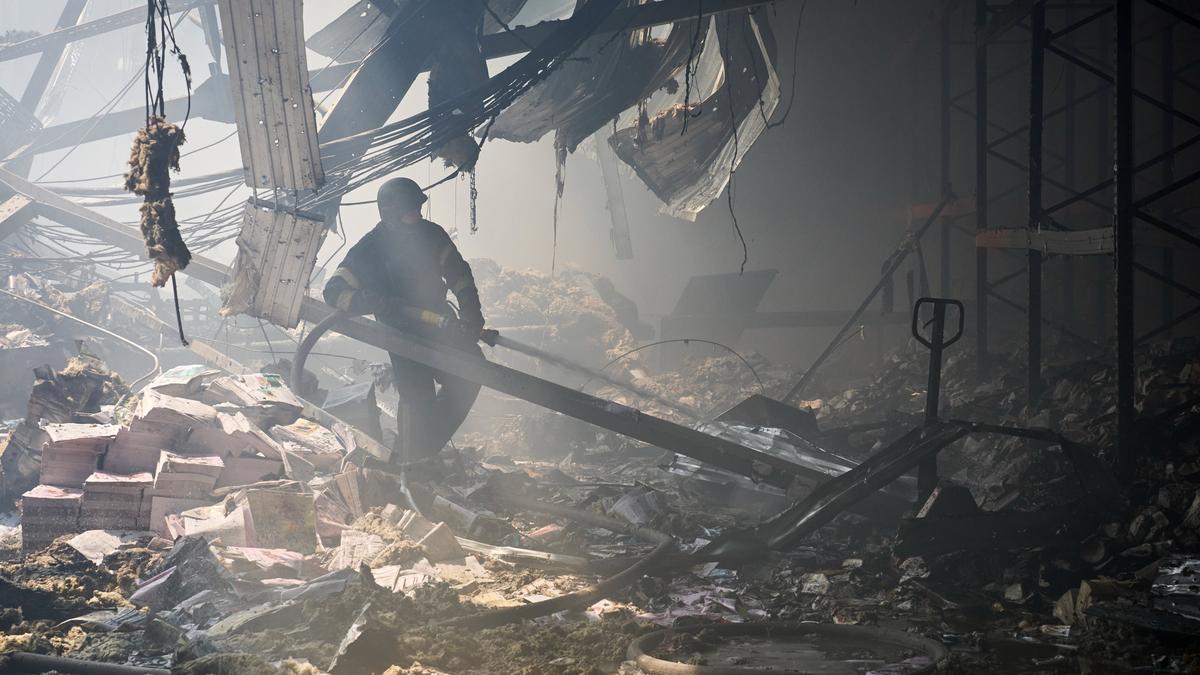Kharkiv. I keep slipping on the mound of wet, charred pages, thinking about how the firefighting foam must be mixed with blood. German for Third-Year Students, I read aloud from one of the few legible pages remaining. Under my feet lie scorched natural science textbooks for elementary schools.
At 10:27am on 23 May, the Russian military fired four S-300 rockets at the Faktor-Druck printing press in Kharkiv. The first one hit the ground just outside the press, blasting a crater into the earth, which is now filled with water. The second rocket hit a book-sewing machine, a clunky but sophisticated piece of equipment essential for book-binding.
Five days after the attack, sun streams into the shop through the wrecked roof and walls. A woman in a coat with the printing press’s logo is sweeping the makeshift path that trails through the mounds of paper. Her eyes are motionless and empty, as if she is cleaning her house after a funeral. But it’s not over yet — only two of the victims have been buried. The remains of the five others who died in the strike are still in the morgue, waiting for DNA test results to come back.
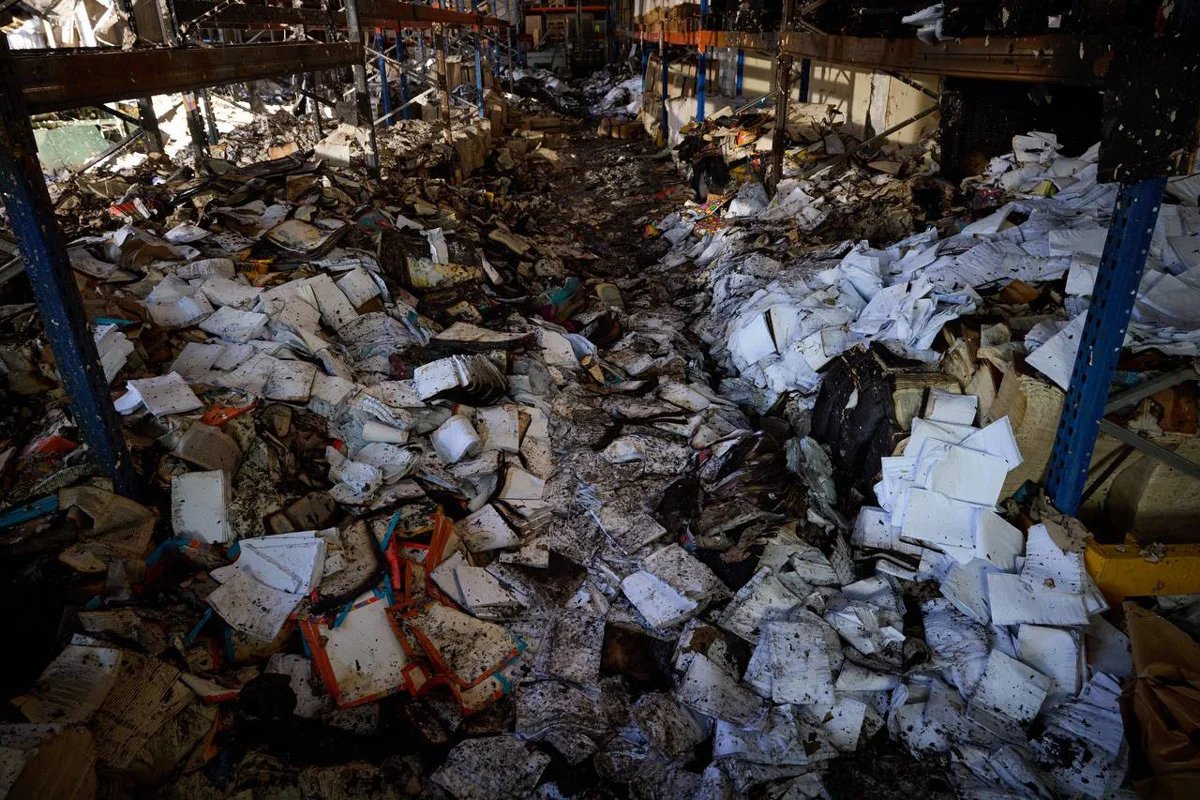
The aftermath of the S-300 attack on the Kharkiv printing press, 24 May 2024. Photo: Office of the President of Ukraine
“I identified the bodies,” Tetiana Hryniuk, the company’s CEO, says firmly, “Though it would be incorrect to call them ‘bodies’. They had been completely incinerated.”
Kharkiv has historically been Ukraine’s publishing capital, and the now decimated Faktor-Druck was once a cutting-edge publishing house even by international standards. Due to the war, the number of people employed by Faktor dropped from 600 to 100, but the demand for its products continued to rise.
“One of the shifts was about to end. Others were going out for lunch in 15 minutes. If the attack had taken place just a bit later, the shop would have been empty,” Hryniuk recalls.
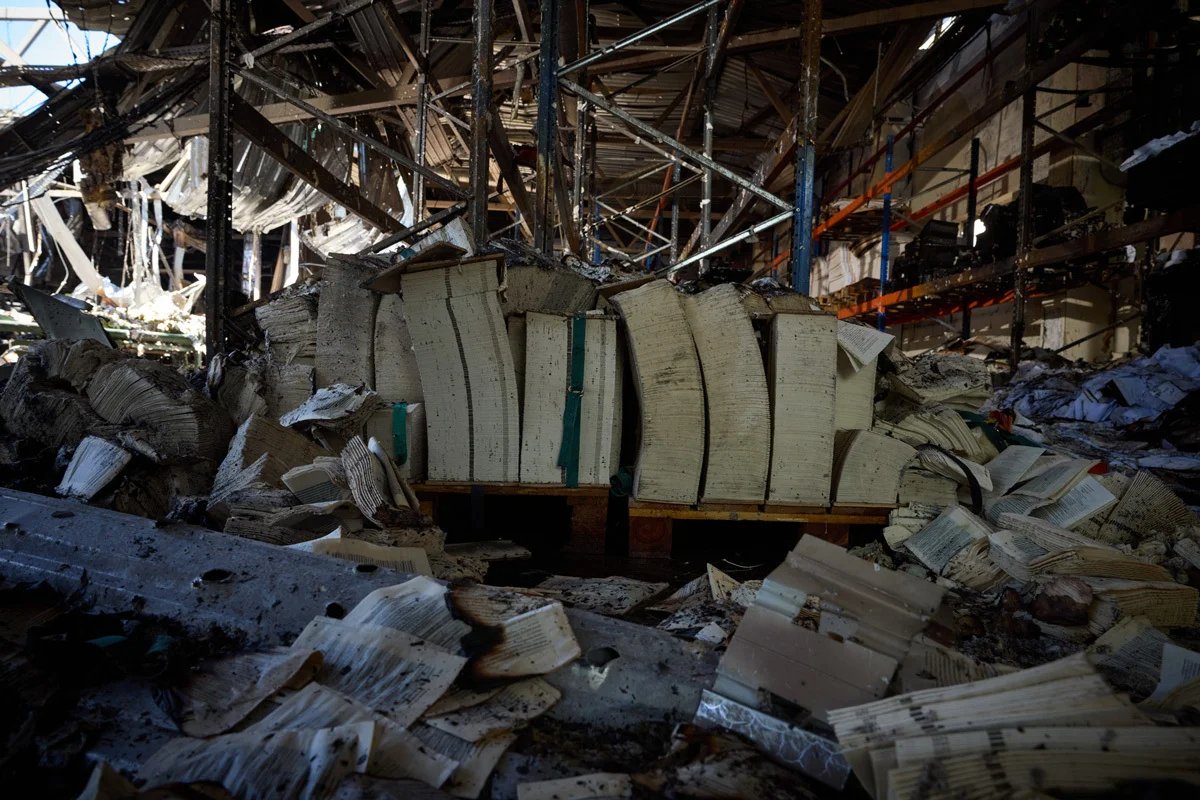
Damaged remnants of the books published by Faktor, 24 May 2024. Photo: Office of the President of Ukraine
Hryniuk was lucky to survive the attack unscathed. Just before the rockets hit, she had gone deep inside the building to take a phone call. Right after the explosion, she, alongside the head of production and other survivors, rushed to pull people out from under the rubble, despite the danger of a second attack.
“You know how they usually do it,” Hryniuk explains with a disdainful “they”. “They wait for people to gather and begin clearing the rubble, and then they hit the same spot.”
They pulled out four people before the rescuers arrived — four people seriously injured, but alive. By the time the rescuers arrived, only dead bodies remained to be pulled out from the ruins.
The swishing of the broom across the floor echoes through the ravaged workshop. Keeping busy helps to cope.
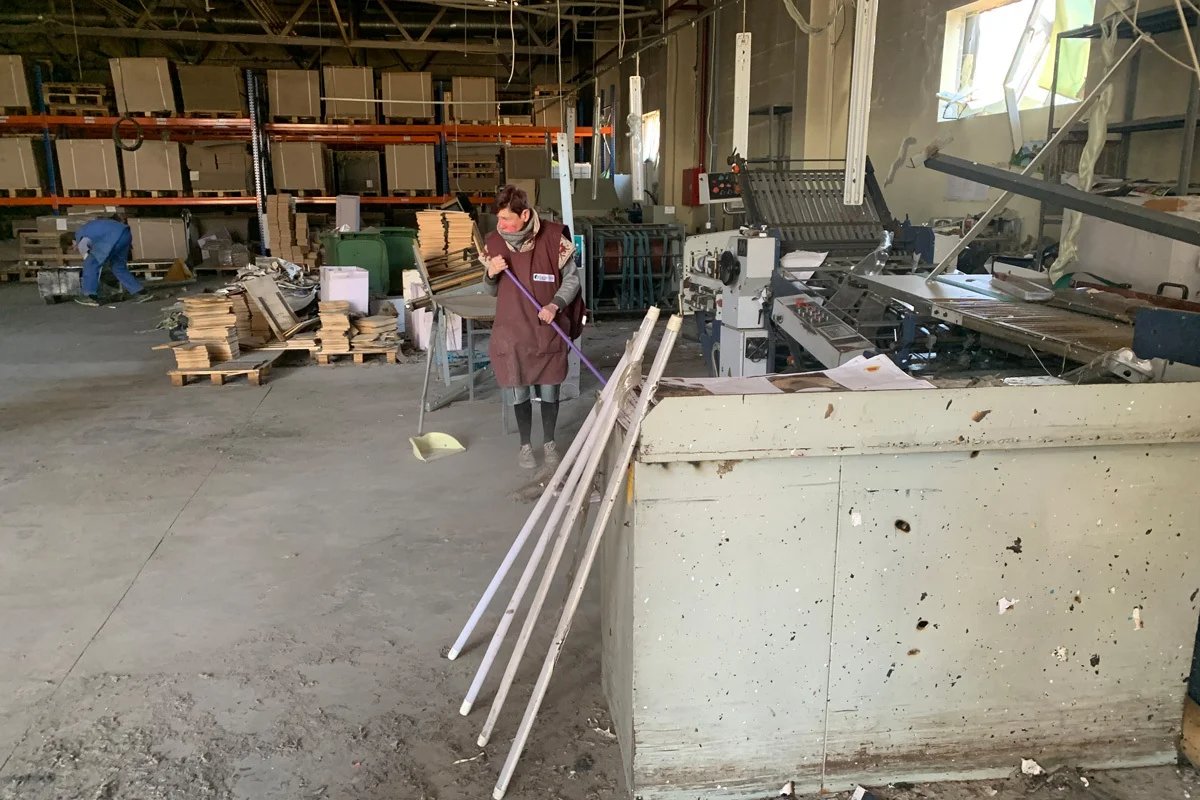
Faktor-Druck employees clean up the book-binding facility. Photo: Olga Musafirova / Novaya Gazeta Europe
‘Where’s mum?’
“[The remains] were found here and here. I had them moved to the garage until the ambulance arrived, because it was cool in there,” Hryniuk says.
“I thought those were body parts, like a burnt arm or leg. But the doctors said that that one piece, about this size,” she gestures, “weighing about 5–7 kilogrammes, was the whole person.”
That piece was presumed to be the remains of Tetiana Khrapina, a printing and foiling operator who had worked at Faktor for 20 years. Tatiana had two grown-up children, a son and a daughter. She was very worried about her son, who had gone to fight for the Armed Forces of Ukraine.
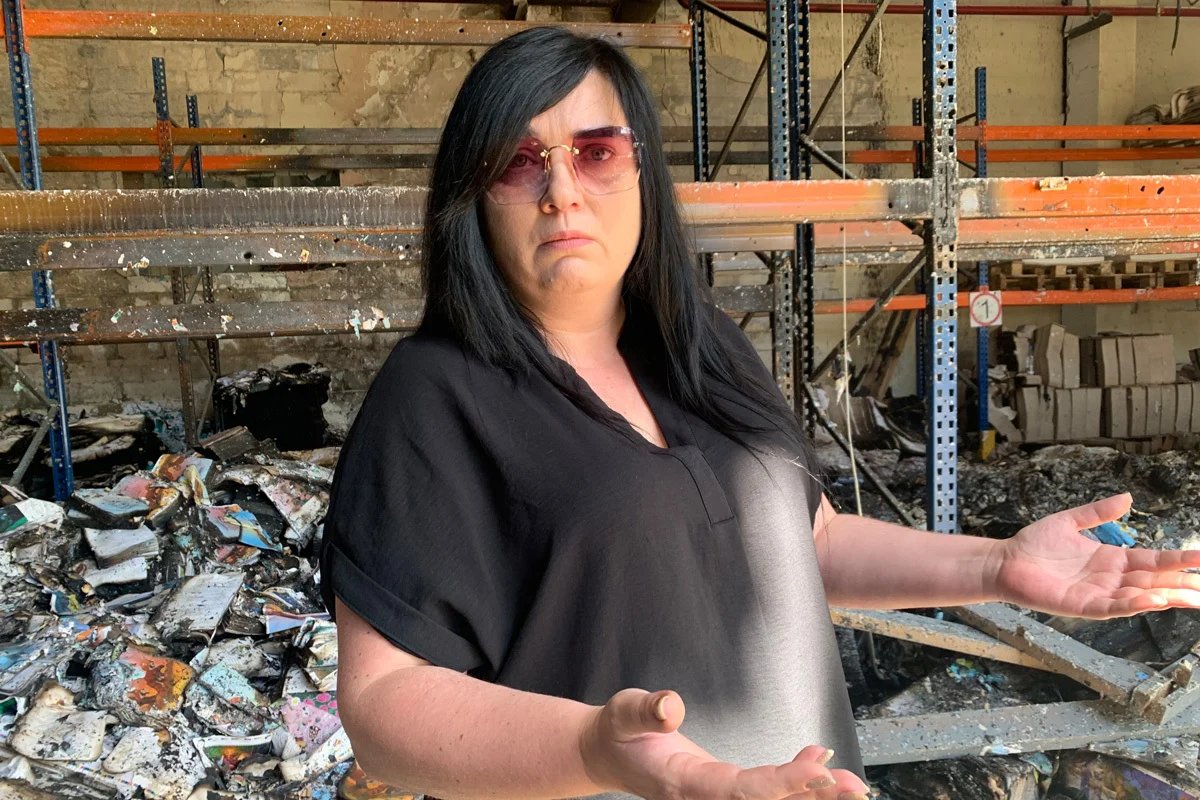
Tetiana Hryniuk shows the size of the remains found. Photo: Olga Musafirova / Novaya Gazeta Europe
When I was writing this story, the final forensics report on Khrapina had not yet been completed. Of the seven employees killed by the Russian military that day, just the two whose bodies were identifiable have so far been buried: Roman Strohyi, a glueing machine operator, and Svitlana Ryzhenko, a booklet maker.
“The only family member who didn’t cry [at the identification] in the morgue was the daughter of Olya Kurasova, our book-sewing machine operator,” says Hryniuk. “I wish she had. I could see that she was in a worse state than those who were hysterical. We were shown a piece that had remnants of a very distinctive chequered fabric. I thought I had seen Olya wearing trousers with a similar pattern.”
“I asked her daughter, ‘Are you ready?’ — ‘Yes.’ — ‘You know what Mum was wearing, right?’ — ‘Yes.’ She stood there staring for a long time and then asked: ‘So where is Mum?’”
Of the seven employees killed by the Russian military that day, just the two whose bodies were identifiable have so far been buried
We approach another pile of mangled metal.
“This was Lena Nenandovska’s workplace. She hadn’t been with us very long, only about three or four years. She was kind and helpful.”
Lena’s son and daughter-in-law identified the burnt body. But then the family of another woman, Svitlana Ryzhenko, arrived and identified the same body. Both women had recently had similar haircuts and dyed their hair black.
“In the end, the body was identified as Svitlana,” Hryniuk says. “Maybe Lena’s family wanted a body to bury instead of a charred fragment, so they convinced themselves that it was her? I don’t know.”
We take another few steps forward.
“Anya Minaeva and Dima Shilo operated the collating machine. Dima’s mother, who’s also one of our employees, is now in hospital with cancer. Her son was her pillar of hope. The only thing left now is to wait to find out which one is which: Dima, Olya, Lena, Anya, Tanya.”
Lena’s son and daughter-in-law identified the burnt body. But then the family of another woman, Svitlana Ryzhenko, arrived and identified the same body.
Hryniuk recalls that as the wounded were being loaded into the ambulance, the firefighters received news that the attacks were coming from Russia’s Belgorod region. This meant that the next strike could come in less than a minute — possibly hitting the same place.
Online, Russians claimed that the printing press had been producing drones.
Newsfeed of doom
In Kharkiv, the tragedies pile up. The deadlier ones overshadow the milder ones, the new obscure the old. Layered together, they create a dismal backdrop for day-to-day life.
Since the beginning of 2023, the Russian military has launched over 1,700 attacks on the city, 230 of them missile strikes. In May, these attacks intensified, as Moscow chose intimidation, the destruction of infrastructure and the mass murder of civilians as their tactics. The Russian objective is clear: to cause panic and to prompt public demonstrations demanding that Kharkiv, a city of over 1 million people, be evacuated. The Kremlin is pinning its hopes on this in turn forcing Ukrainians to demand that President Volodymyr Zelensky enter into peace negotiations with Moscow.
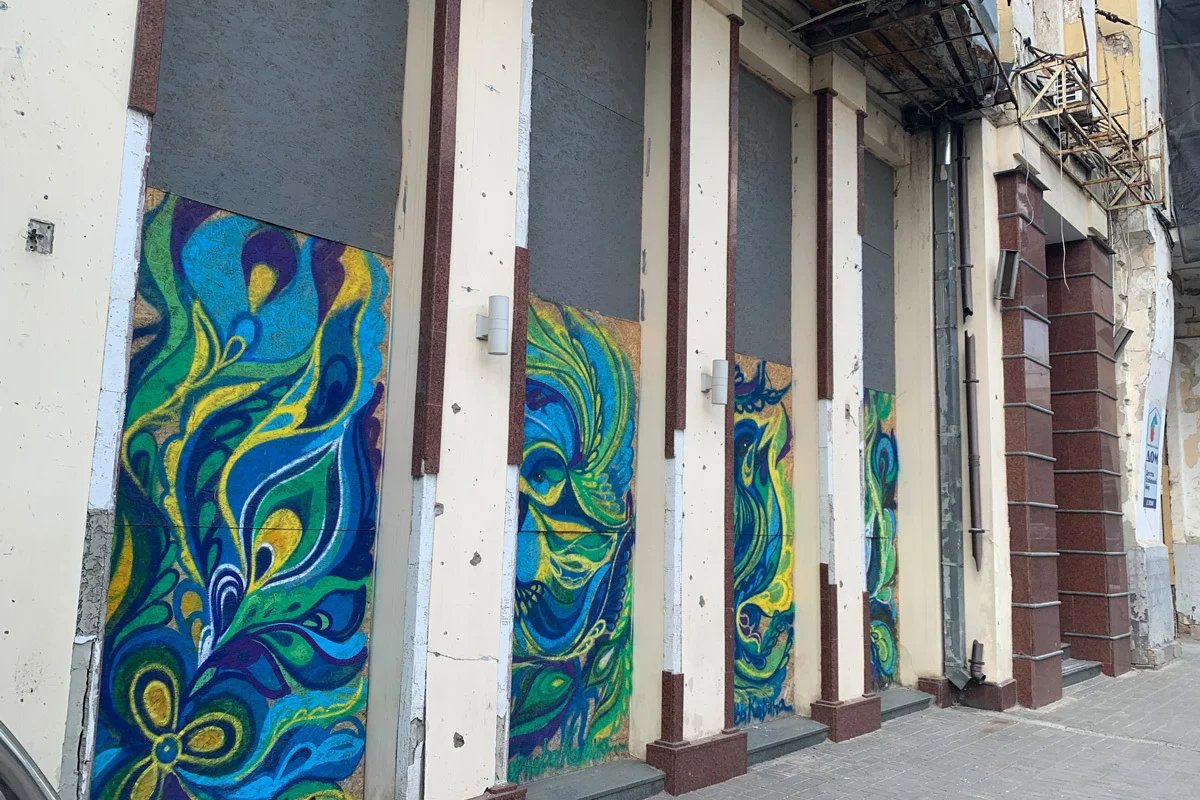
Plywood covers for blown-out windows have been turned into art objects in the centre of Kharkiv. Photo: Olga Musafirova / Novaya Gazeta Europe
On 23 May, the missile strike on Faktor-Druck claimed seven lives. The direct damage from the destroyed buildings and equipment amounts to €5-6 million.
On 25 May, UMPB D30 glide bombs struck Epitsentr, a DIY hypermarket, in the middle of the day. It took first responders four days to clear the rubble and to sift through the ashes to recover even the tiniest body pieces, by which time the death toll had risen to 19: 11 men, six women and two children.
An unexploded glide bomb was later found 80 metres from the hypermarket. If it had reached its target and detonated, the death toll would have been much higher.
On May 25, the Russian military dropped another bomb — this time on Kharkiv’s central recreation park. Fortunately, there were no casualties.
On May 27, glide bombs struck an industrial zone in Kharkiv. Two factories, one making sweets and the other irrigation equipment, were hit. One woman was killed, 11 others were wounded, some of whom remain in critical condition. And the list goes on…
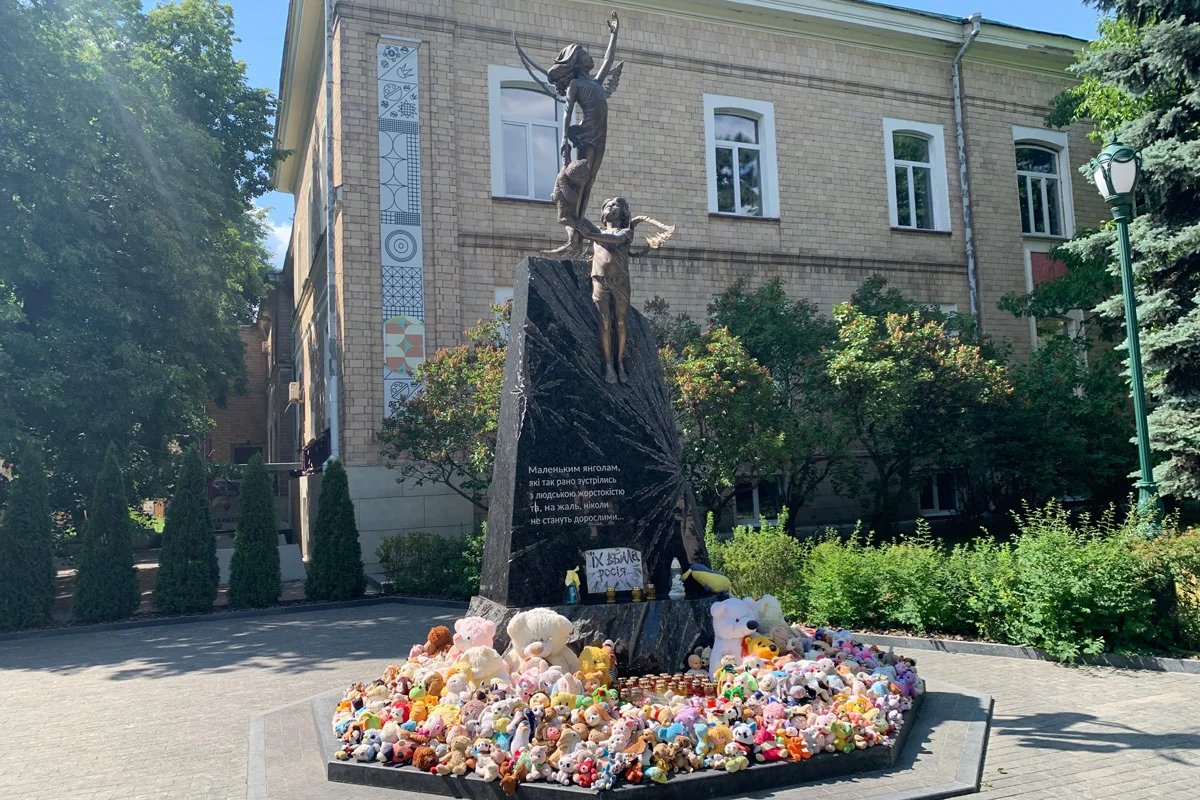
A monument to minors killed in bombing in Kharkiv. Photo: Olga Musafirova / Novaya Gazeta Europe
Fatalists and optimists
During the three days that I spent in Kharkiv, there were barely any intervals between the air raid sirens. As a Kyiv resident, what scared me most of all wasn’t the sirens themselves but rather the silence that followed them. There wasn’t a single bang from air defence systems — yes, Ukrainians have learnt to distinguish the sounds of the different explosions.
Russian missiles launched from the S-300s stationed just over the border in the Belgorod region follow a ballistic trajectory, making them nearly impossible to shoot down. Indeed, the warning system is sometimes only activated after an attack has already taken place as it can take a missile less than a minute to reach Kharkiv.
After yet another air raid siren, I duly went down into the metro, having been taught not to ignore warnings, only to find that the station was empty. Bombings have become such a part of day-to-day life that the people of Kharkiv have become fatalists.
“There’s a spy drone flying around again,” the barista at my hotel says to the girl on the reception desk, before adding, without missing a beat, “wanna get lunch?”
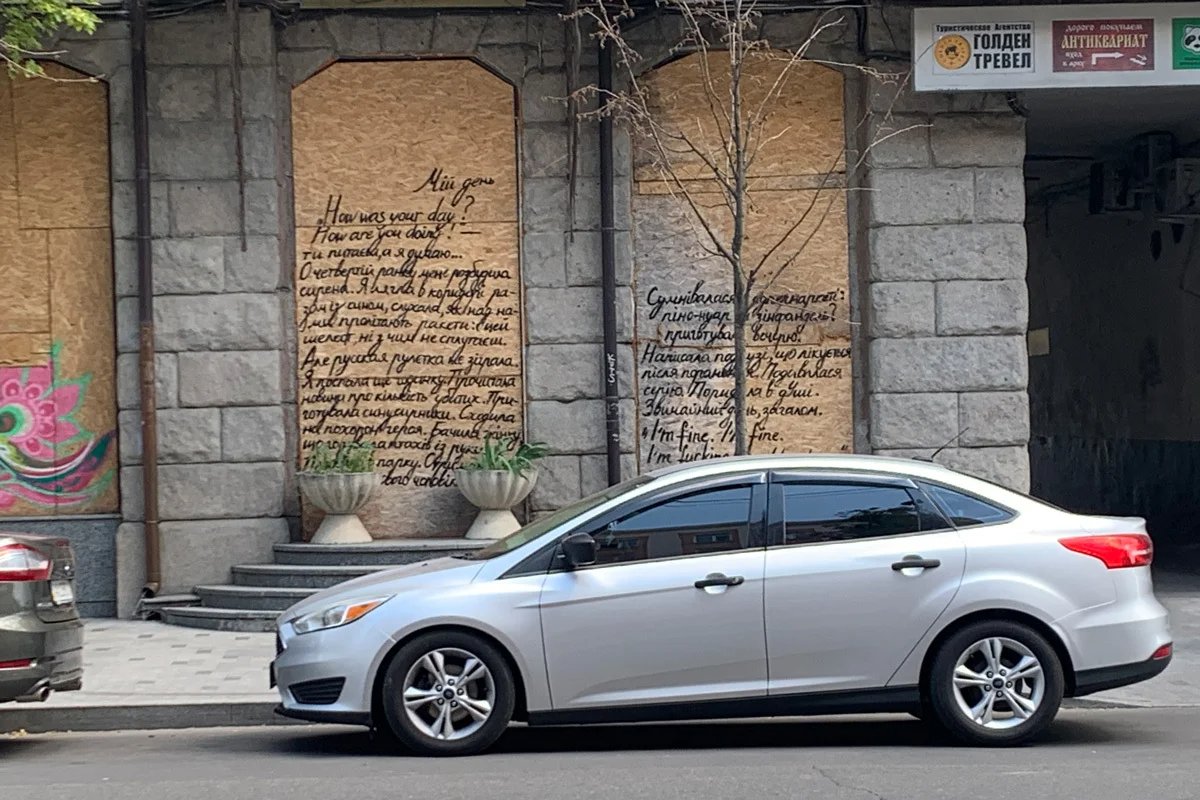
Plywood covers for blown-out windows turned into art objects in the centre of Kharkiv. Photo: Olga Musafirova / Novaya Gazeta Europe
Grocery stores, coffee shops, chemists, banks, and public transport in the city all continue to operate. Some of the plywood shields that cover bombed-out windows have become art pieces of their own.
The streets are mostly empty as many people have left the city. In May, Kharkiv’s mayor, Ihor Terekhov, begged world leaders and Western partners to provide the city with its own Patriot missile defence system, like the ones that defend Kyiv. But the Russian border is so close that the Patriots themselves would become targets, which leaves only one effective way to defend Kharkiv — using long-range weapons to strike military objects inside Russia.
Children of the underground
From the outside, the world’s first underground school looks fairly nondescript, with just a minimalist sign saying “shelter” giving its location away.
The school is, in fact, a 1,250-square-metre bunker with the highest degree of radiation protection, a ventilation and sewer system, and backup water supplies and power sources. In short, this safe space in one of the most frequently bombed-out districts of Kharkiv boasts everything a school could want, with the exception of windows.
Two flights of stairs and a wheelchair lift take you down six metres below the ground to a corridor that’s bathed in artificial light, off which doors painted in bright, warm colours lead to 20 different classrooms.
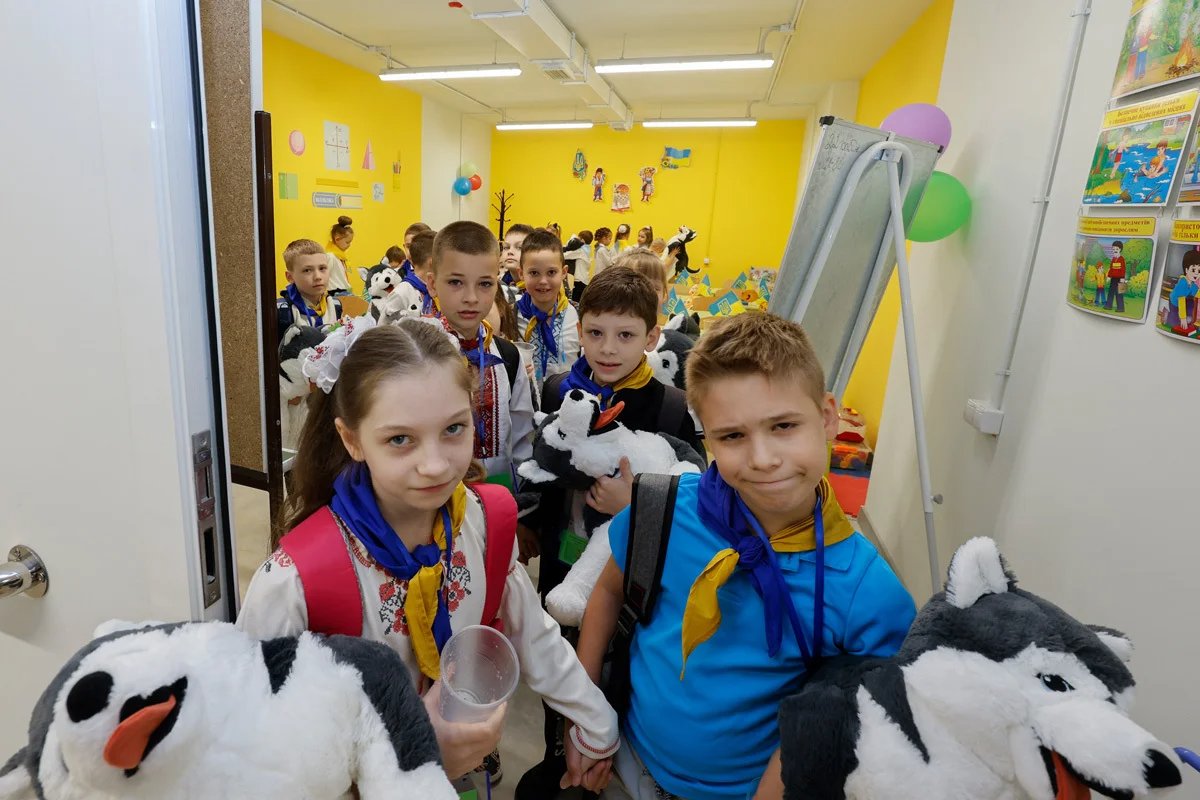
Pupils of the underground school in Kharkiv. Photo: Sergey Kozlov / EPA-EFE
“You can’t hear the explosions down here at all,” the school’s headteacher Valentyna Pukhlyi, tells me. “So both pupils and teachers feel more relaxed here. The children come back to life emotionally and start laughing, running and shouting again.”
“And then they go home and the nightmare resumes,” I can’t help blurting out.
Resettled children from the Russian-occupied cities of Kupyansk, Borova, and Izyum also attend the underground school, and must be impressed by how pleasant and relatively calm things in the city are compared to their own hometowns.
“The underground facility, which can accommodate 900 students, took just over six months to build while Russian bombs rained down on Kharkiv. It was built using money from the city budget,” says Olena Zbitskaya, head of the district office of the Department of Education, who credits Mayor Terekhov with the idea.

Olena Zbitskaya in the underground school. Photo: Olga Musafirova / Novaya Gazeta Europe
Some of the classroom doors are ajar as we talk in the corridor. Shortly before the lessons begin, the Ukrainian national anthem plays.
“I have no right to retell their stories,” says Pukhlyi, “But there are children here whose family members have died at the front, fighting for our freedom. Others have had their homes destroyed by Russian missiles.”
Second-graders sit at their desks, discussing the upcoming summer vacation:
“I’ll visit my grandmother in the village and go fishing! I’ll catch a fish this big!”
“You can’t go to the river — there are mines there.”
The mayor’s office is now preparing to open underground intensive care and surgery units.
Join us in rebuilding Novaya Gazeta Europe
The Russian government has banned independent media. We were forced to leave our country in order to keep doing our job, telling our readers about what is going on Russia, Ukraine and Europe.
We will continue fighting against warfare and dictatorship. We believe that freedom of speech is the most efficient antidote against tyranny. Support us financially to help us fight for peace and freedom.
By clicking the Support button, you agree to the processing of your personal data.
To cancel a regular donation, please write to [email protected]
